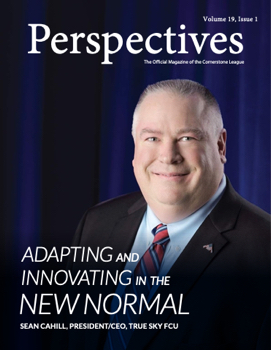

Better together: Survival, collaboration, and consolidation
By Caroline Willard, President/CEO, Cornerstone League
Here’s a thought experiment for you. If Louise Herring were to somehow time travel to 2022, would she be proud of the legacy she built? What would she think of bankers’ attacks on credit unions, the interchange debate, or the hold financial technology has on consumers?
What would she do to ensure credit unions’ sustainability in today’s environment?
I believe the Mother of Credit Unions would draw from her famous quote, which encapsulates her resolve: “… the purpose of the credit union is to reform the financial system so that everyone can have his place in the sun.”
She would tackle the issue of ensuring credit unions’ sustainability by leveraging the gumption she displayed at 24 years old when she rode the bus to Estes Park, Colo., for the 1934 meeting that would establish the Credit Union National Association. She would tighten her focus, keeping her eye on the prize like she did when she ignored unfriendly comments and stares from her colleagues in those fateful days nearly 100 years ago.
Her resolve prevailed as she signed the original constitution for the national association that became CUNA, later co-founded the Ohio Credit Union League, and organized more than 500 credit unions.
And while in 2022 we find ourselves in a vastly different world, obstacles not unlike those Herring experienced still threaten our efforts to keep the credit union movement alive.
Which brings me back to her quote, “… the purpose of the credit union is to reform the financial system…”
Like Herring, I believe it’s time to reform the infrastructure that surrounds, supports, and advances our credit unions.
As certain forces seek to take us down, dismantle, and discredit the movement, we can mobilize our credit unions to do what we’re meant to do: provide unbridled access to affordable financial products and create financial well-being for all, but in a transformative way. As I’ve challenged my colleagues in the last year to ponder the question “Will credit unions be around in 100 years?” I can’t help but draw a direct line between survival, collaboration, and consolidation.
Survival
Survival is a person’s most powerful instinct. We go to great lengths to protect the existence of those we most care for. In 173 years, credit unions have thwarted many attempts on their existence. In spite of adversity, credit unions have consistently shown up for their communities and themselves, coming out of each crisis stronger than before.
And how do you suppose we achieve that? Through the power of collaboration.
Collaboration
This is where our movement stands apart from other industries. Those who know me know this story: when I found my home in the credit union movement more than 20 years ago from the strange, siloed world of thrift banking, one of the first things that struck me as different was how collaborative credit unions were. There were no secrets. If there was a way to help our neighboring credit union, we were going to share that secret sauce. I admit it was counter-intuitive at first. As schoolchildren, we are raised to guard our tests for fear of our neighbor copying our answers; we’re so quick to stamp every innovation as confidential. But it’s this collaboration that not only sets us apart from other industries, but also keeps us alive.
Collaboration yields innovation. Two heads are better than one. Put five heads together and you’ve got a formidable team. Twenty, 100, or 500 heads… you’ve got a revolution.
Consolidation
Long-term analysis conducted by Graeme K. Deans, Fritz Kroeger, and Stefan Zeisel about mergers around the globe has found that most industries progress predictably through a clear consolidation life cycle. Through a study of 1,345 large mergers completed over the span of 13 years, the researchers concluded that once an industry forms or is deregulated, it will move through four stages of consolidation: Opening, Scale, Focus, and Balance and Alliance.
The research suggests that every company in every industry will go through these four stages—or disappear. According to business best practices company Flevy: “Every major strategic and operational move should be evaluated with regard to the industry’s stage in the Consolidation Curve.”
Consolidation in the credit union world has been controversial. If two credit unions merge, the number of credit unions diminishes. Consolidation may lead to duplication of talent, create instability, and disrupt operations.
But consolidation can give way to revolutionary innovation. Combining two entities can create a powerhouse, strengthening the organization’s position in the marketplace. This is evidenced in the consolidation of credit union leagues over the years, including the 2013 consolidation of the Texas Credit Union League, Oklahoma Credit Union Association, and Arkansas Credit Union Association to create the Cornerstone Credit Union League. This consolidation strengthened our value proposition to our members, creating an advocacy, education, and resources powerhouse that has proven successful for our members.
Consolidation of entities like ours, the Carolinas, Northwest CUA, LSCU, and most recently Go West, has reduced fragmentation and bureaucracy. State-by-state advocacy patchwork strategy has given way to more streamlined efforts. And in an era when the demand for talent and jobs is high, consolidation can create more substantial employment hubs, attracting high-quality regional talent, and developing bench depth.
Exploring the possibilities of innovation can lead to transformative change in the marketplace. Beefing up the cooperative model through consolidation can preserve the unique role of financial cooperatives in the marketplace while elevating your value proposition to the next level. By removing the barriers and building our industry presence through consolidation of league support, credit unions can continue to fight regulatory burden and preserve the vision of our movement’s founders. Ushering in a new era of league infrastructure might be the key to securing our future success.
Which brings me to our current exploration of a merger with Heartland Credit Union Association. We have been busy lately, conducting due diligence and meeting with as many Cornerstone League and HCUA members as possible to discuss the finer points of the merger in real time and answer your questions. We’ve launched a merger FAQ page on the Cornerstone website, which features a timeline of our activities, important milestones, and frequently asked questions.
The credit union movement may have changed, but the power to continue to carry out the vision of our movement’s founders remains in our hands. Louise Herring may have some questions and concerns about what’s going on right now, but I think—after all questions were asked—she would remind us of our purpose: “… to reform the financial system so that everyone can have his place in the sun.”
Subscribe
Sign up to the receive the weekly Leaguer email. Existing subscribers can manage their subscription.

